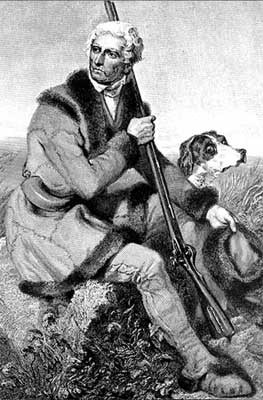
A LEDGEND NAMED BOONE
By Bob Jamison
Did you ever have the yearning for the unusual adventure? Maybe you’d like a kayak trip down the Yellowstone River in Wyoming or Montana. Or how about experiencing the very unusual atmosphere while hiking in the equatorial regions of the Amazon. Well, we can dream. Or, on the other hand, we might pick up a publication about many of our own ancestors and their adventures.
Prior to the days of the American Revolution the population of The Colonies was growing with immigrants from many parts of the world. The likes of native sons as Daniel Boone were born east of the Appalachian Mountain range near Reading, PA. His father immigrated there from a village in Devon, England. Other relatives were from Wales.
No doubt his father’s adventure purely considered the unknown. What they did know was England didn’t have the attraction of vast land, rich soil and an abundance of game. So, the thought of being free of serious taxation and some suppression, they came to the New World.
Daniel Boone was born 11-2-l734 of the Quaker religion. His father Squire Boone would discover that one day Daniel would become a world wide hero of adventure. Daniel left the Quaker community because reprisals of his sister marrying a “worldling” (non Quaker). But he was a professed Christian. He was a successful hunter and trapper that traveled many miles away and sometimes months at a time from home. During those years he raised a large family and made his mark as a woodsman, soldier, and husband and even served in the legislature. He often said about his journeys, “I’ve never been lost; but, I’ll admit I’ve been confused a few weeks at a time.”
Daniel Boone’s reputation of being a competent surveyor and a brave leader would face incredible danger from the elements, not the least of which were wild animals, savage Indians, the French and even the British. The French teamed up with the Indians (French and Indian War (l754-l763) and then it was the British who paid the Indians to attack the revolutionaries and their families.
For 150 years American colonist were boxed in the East Coast by the Appalachian Mountain range. But rumors and frequent reports of wonderful land west of the mountains were brought back by Cabriel Arthur who was, in part, given credit for discovering the now famous Cumberland Pass. However, the tribes of Shawnee and Cherokee Indian tribes were quite aware of the Pass (commonly known as Warriors’ Path) and intended to protect it from settlers moving west.
Many looked for the one individual that had the courage and the ability to locate Cumberland Pass and lead the anxious and enthusiastic fellow adventurers who set goals for themselves and their families regardless of the hardships that lie ahead. That individual was, of course, Daniel Boone. This daring explorer was not invincible though. During one of the journeys his son James Boone was captured and tortured to death by Indians. But Boone continued leading others through Cumberland Pass. In another event, the Indians captured his daughter and another girl. Boone followed the Indian party for two days and rescued the girls. Later Boone himself was captured but gained respect of the Indians and he later escaped.
Eventually, he arrived in an area he felt of great promise. He encouraged his followers to build a fort there. The town still stands near Pineville, Kentucky at the mouth of the Otter Creek on the Kentucky River. The name of the town is Boonesboro, KY.
Much has been said and written about this famous American. It would seem to most of us that it could be possibly a legendary “figure” of our history. Quite on the other hand, many students of the American Revolution who have made extensive studies of genealogy have made surprising discoveries of links to the very folks, kin or fellow adventurers of Daniel Boone who live today right here in Liberty County, Texas. A lot of this credit can be given to the well known national organization called The Daughters of the American Revolution (DAR). Or even the counter part the SAR.
One local descendent (spouse of this writer) of the Barclay and Crews clan joined Boone in the settlement of Boonsboro in early l777. Crews, a land grant recipient, later built his own place called “Crews Station” near Richmond, Kentucky in l88l. Though he became a larger land owner and a Quaker, Crews went to war more than once. Naturally, the first was against the Shawnee Indians and later fought the French and Indians as did Boone. Both received land bounty certificates for their heroic service in the arduous expansion west.
Truly a legend, Daniel Boone is still a part of this nation’s history. With virtually no education, he traveled with two of his favorite books: Gulliver’s Travels and the Holy Bible. Boone made his last hunt at age 83. He died in 1820 as an American true and legendary hero.